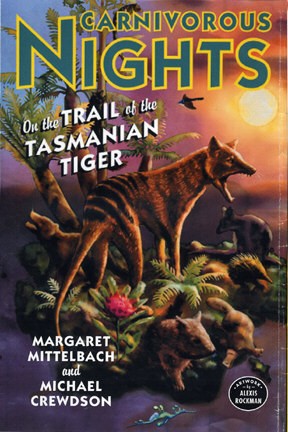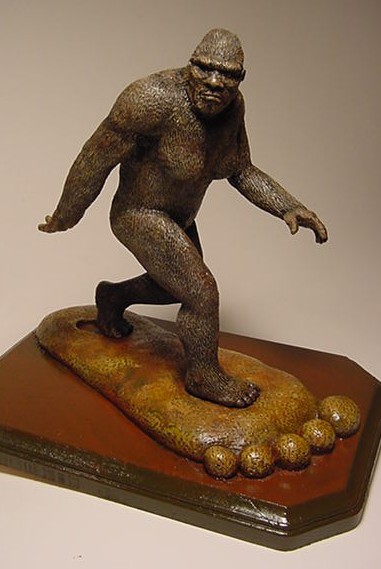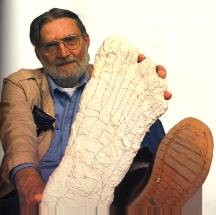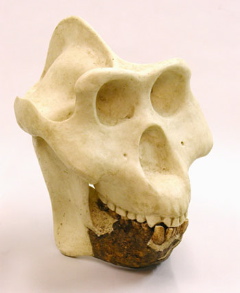Going Through Security, Cryptozoologically
Posted by: Loren Coleman on March 28th, 2009

I was re-reading part of the book Carnivorous Nights: On the Trail of the Tasmanian Tiger by Margaret Mittelbach and Michael Crewdson, and it reminded me of some of my amusing encounters with airport security personnel. First, let me share their story.
The book is illustrated by Alexis Rockman, whom I know because he contributed his giant catfish painting to the cover of the 2001 edition of Mysterious America. We were also involved in the Bates cryptozoology exhibition together.
There is a funny passage involving Alexis, Margaret, and Michael and their planned trip to Tasmania to seek evidence of the Thylacine. It involved one incident that happened as they began their journey from Melbourne to the island.
+++from pages 46-47:
…we were at Melbourne’s Station Pier, entering the ferry’s cavernous bowels. Hundreds of cars were creeping on board and stacks of pet-filled cages were being rolled off to an unseen kennel area. Because of Tasmania’s island status – freedom from many of the exotic species that plagued the mainland – restrictions on bringing in plants, animals, even certain types of food were taken very seriously. We joined a line of passengers waiting to have their luggage checked. Every bag was opened, poked, and occasionally thoroughly searched. According to a pamphlet we had been given, the inspectors were primarily looking for fresh fruit and illegal animals, such as foxes and pythons. But Alexis looked nervous.
“Did you bring the P-O-T with you?” we whispered loudly.
“Shhhhhhh…I was afraid to bring it on the plane from Sydney. But I got some more here. It’s way down in the stuff sack of my sleeping bag.”
When it was Alexis’ turn to have his bag searched, he suddenly became oversolicitous and hyper. “Do you want me to open that for you? No problem. I can undo that strap. Do you need me to unzip anything? How about this? This? No, thank you.”
When we heaved our bags forward, however, the inspector gave us a piercing look. We had been selected for extreme searching. She carefully opened each compartment and removed our things; clothes, underwear. Then she pulled out a stack of books we were carrying and stared at the title on top. We hoped it was something like The Future Eaters, an irreproachable ecological history of Australasia. But when we glanced down, we saw it was Cryptozoology A to Z: The Encyclopedia of Loch Monsters, Sasquatch, Chupacabras, and Other Authentic Mysteries of Nature.
“Okaaay, then,” she said, rapidly shoving our stuff back inside our bags. “You have a nice trip.” We followed Alexis and Dorothy on the upper decks.
+++
Amusing. But more commonplace than you can imagine.
I travel a good deal more than I even realize. The trips to go investigate sightings or do fieldwork are often rather routine, as besides gear that looks like I’m going camping, the stuff I pack doesn’t raise many eyebrows. However, in these days of airport security and searches, getting all kinds of looks regarding what I have in my carry-on bags when I’m flying very cryptozoologically can be interesting, to say the least.
As a rule, if I’m going to be interviewed by a documentary film company or am giving a talk, I bring along cryptozoo artifacts, props, if you will, to enhance the verbal component with a little visual evidence or replica example of the cryptids.
When I started traveling during the early days of airport searching, often I would experience agents taking apart my bags, finding my Bigfoot footcasts and passing them around to their colleagues to “have a look.” Generally there were lots of laughing, smiles, and little serious work associated with such dives into my luggage. I was that strange curiosity, which seemed to be break their days, and a Yeti cast that was twice the size of one of their hands was something they didn’t see every day.
After awhile, I began to figure out that it would be best, not for ego reasons, but as a way to explain things more quickly, if I also packed at least one of my books with the cryptozoological artifacts. It sped up things, you see, if I could say something like, “Well, the reason I have that polyurethane cast of the footprint from the Patterson-Gimlin Bigfoot 1967 trackway from Bluff Creek, California, you see, is that I write these popular cultural books on Bigfoot – see like this one – and I’m flying to Washington State to be interviewed about it.”
It really did help, and my journey through the lines was always a bit quicker, if the expected questioning came up.
Also, I began to learn that when they pulled out the figurines of Mothman, Bigfoot, Jersey Devil, and more that I might be carrying along to help with interviews of eyewitnesses, it was easier just to smile and say, “Oh, you got to get the kids some toys, don’t ya?”

Yes, Bigfoot collectibles, like Jeff H. Johnson’s sculpture of the Patterson-Gimlin Bigfoot (above), though it is not exactly a toy, can be called such when your bag is searched, to speed your day along.
Slowly, I have learned the best way to greet the more serious post-9/11 faces of security is with humor, honesty, being at ease, and if pushed, calmly trying to modestly explain that a television producer was to blame for that funny-looking weirdness in my bag.
🙂

That is, until I tried the ultimate piece of carry-on. You see, there was this time, only a few years ago, when I was flying to Los Angeles from Maine to be on two programs in one long weekend. The request from the filmmakers was to bring along something really dramatic that would show up on the table in front of me. Since I was talking about the theories regarding the candidates for Bigfoot, I thought I would do Grover Krantz the honor of respectfully representing his theory.
I decided to bring along my copy of his dark brown, aged-looking lifesize reconstruction of the complete skull of Gigantopithecus. If you’ve never held it, take my word for it. The thing is massive. It is over 15 inches tall, with that crest, and the mandible itself is 7 inches by 7 inches. It is heavy too.
No problem, I thought. It’s huge but certainly doesn’t have any sharp edges, and I can’t use it to highjack a jet. But something weird happened during my journey. For some reason, in Chicago, at O’Hare, going from one airline to another, I had to go in and out of airport security. Things were very uptight in 2003, and airport security was taking itself quite seriously. At O’Hare, I had to go through the search all over again, even though I’d done it all at Portland before.
You guessed it. I was singled out, and had to go over to the side, where the possible father rapers and illegal aliens were placed in holding. I got the special session of questions, but, as I was to find out, not due to any fear they had that I was a terrorist. No, they were concerned because they thought I was carrying a real giant bone skull.
Whoa. I hadn’t brought along any papers for this skull. I never thought I would need such a thing. I was sweating, I must say. I didn’t want to leave this big boy behind with TSA! It took me some time to define “resin” and “replica” for them, let alone “cryptozoology” and “Gigantopithecus.” But, I was finally released, perhaps also due to the book of mine I had along to show what the heck I was talking about. I did make my flight to LA. Luckily, I had no problems on my return trip home.
Needless to say, I don’t take the Gigantopithecus skull with me anymore, unless I’m driving to my destination.

My copy of the Gigantopithecus reconstruction, shown here in this BonesClones skull, is all resin and entirely the same color as the small brown patch seen in this mandible. It makes it look like an old fossil, apparently, to airport security personnel.
So, you can see, I was happy to re-read that passage from Margaret Mittelbach and Michael Crewdson, and recall that I wasn’t alone with these kinds of encounters. Have you had any experiences on your trips of getting through travel security, cryptozoologically?
Yes, your support is still very much needed on this Saturday, March 28th, and so, today, please do…
Thank you!
About Loren Coleman
Loren Coleman is one of the world’s leading cryptozoologists, some say “the” leading living cryptozoologist. Certainly, he is acknowledged as the current living American researcher and writer who has most popularized cryptozoology in the late 20th and early 21st centuries.
Starting his fieldwork and investigations in 1960, after traveling and trekking extensively in pursuit of cryptozoological mysteries, Coleman began writing to share his experiences in 1969. An honorary member of Ivan T. Sanderson’s Society for the Investigation of the Unexplained in the 1970s, Coleman has been bestowed with similar honorary memberships of the North Idaho College Cryptozoology Club in 1983, and in subsequent years, that of the British Columbia Scientific Cryptozoology Club, CryptoSafari International, and other international organizations. He was also a Life Member and Benefactor of the International Society of Cryptozoology (now-defunct).
Loren Coleman’s daily blog, as a member of the Cryptomundo Team, served as an ongoing avenue of communication for the ever-growing body of cryptozoo news from 2005 through 2013. He returned as an infrequent contributor beginning Halloween week of 2015.
Coleman is the founder in 2003, and current director of the International Cryptozoology Museum in Portland, Maine.










Cryptozoology has certainly made for some interesting flights. On one of my trips, airport security did everything except strip search me, going through my carry-on and asking lots of questions. It probably didn’t help at first when I tried to avoid the subject and say I was just doing nocturnal “wildlife research.” Then again, when I finally told them what KIND of wildlife I was researching, it didn’t seem to make them any more suspicious, maybe they just thought I was wacky and harmless. My research equipment, like pepper spray (good for unfriendly mammals), animal-handling gloves, and a Mestel gas mask (nationals in one area were pretty consistent in their tales of a cryptid spraying a toxic vapor), probably contribute to the likelihood I’ll get searched.
I think I would have been MORE concerned if the conversation had gone:
TSA – “Sir, what’s in the bag?”
Coleman: “Underwear, socks, toothbrush, and a giant skull of a large pre-historic ape.”
TSA: “Okay, move along.”
Priceless…
You’re supposed to bundle that stuff in scientific-y looking display cases.
Hauling it around with your personals definitely means you’re growing Peyote out in the hills 😉